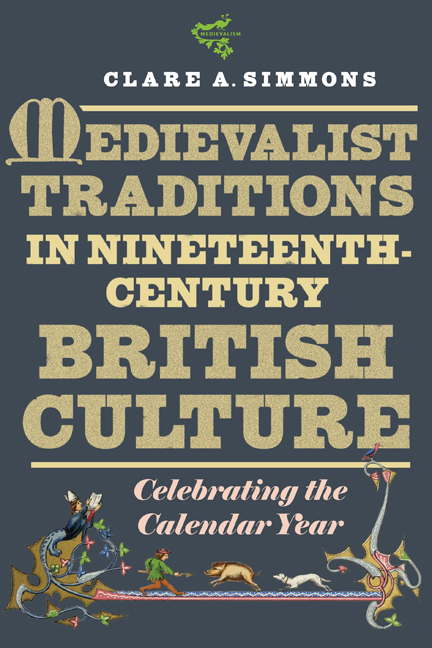Book contents
- Frontmatter
- Dedication
- Contents
- List of Illustrations
- Preface
- Acknowledgments
- List of Abbreviations
- Introduction: Medievalizing Time
- 1 The Christian and Not-So-Christian Year
- 2 Medievalist Calendar Experiments
- 3 Christmas Becomes a Season
- 4 Winter Love: St Agnes and St Valentine
- 5 Rites of Spring: Imagining Origins
- 6 Summer Festivals: Religion in Performance
- 7 Fragmented Autumn: Harvest-Home to Lord Mayor's Show
- Epilogue: Christmas Ghosts
- Bibliography
- Index
- Miscellaneous Endmatter
- Frontmatter
- Dedication
- Contents
- List of Illustrations
- Preface
- Acknowledgments
- List of Abbreviations
- Introduction: Medievalizing Time
- 1 The Christian and Not-So-Christian Year
- 2 Medievalist Calendar Experiments
- 3 Christmas Becomes a Season
- 4 Winter Love: St Agnes and St Valentine
- 5 Rites of Spring: Imagining Origins
- 6 Summer Festivals: Religion in Performance
- 7 Fragmented Autumn: Harvest-Home to Lord Mayor's Show
- Epilogue: Christmas Ghosts
- Bibliography
- Index
- Miscellaneous Endmatter
Summary
These facts, however, are not found in history.
(John Henry Newman, “The Life of St Bettelin”)Early collectors of British popular traditions such as John Aubrey, Francis Grose, and Henry Bourne make frequent reference to activities tied to particular times of the year. In the nineteenth century, though, these references become more and more wistful. Britons acknowledge that if their country ever had a cohesive society, it is becoming increasingly divided between rich and poor, urban and rural, as lives are centered more around work than around community events.
This study examines how nineteenth-century Britons connected seasonal celebration with a conception of the medieval past that helped them think more sympathetically about what their ancestors’ lives may have been like before the Reformation. At a time when Britain was the most industrially advanced nation in the world, many vaunted the superiority of the present to the past – yet others, and not necessarily only those who imagined their forebears as feudal overlords, felt that if shadows of past ways of life haunted the present, they were friendly ghosts.
The focus here is on these ghosts: not on the discovery of to what extent nineteenth- century ideas about their inheritance from Middle Ages were accurate, but on how medievalist writings created a cultural idea of the Middle Ages and its traces in present practice. Some of the writings discussed, such as works by Tennyson and Dickens, have remained central to our own ideas about the nineteenth century. Many others, especially those in ephemeral publications, are not so well remembered – yet they both reflect and help create a new appreciation of the medieval period. Medieval-inspired works could be accessed not just by the most privileged members of society but by readers of a wide range of publications. While only the wealthy could afford to subscribe to the works of antiquarian clubs such as the Roxburghe and Percy Societies, magazines and almanacks aimed at middle-income households often lampooned the Middle Ages but nevertheless showed a grudging admiration for the medieval style; while works marketed to poorer readers, such as those printed by William Hone, were often socially critical in their comparisons between past and present.
- Type
- Chapter
- Information
- Medievalist Traditions in Nineteenth-Century British CultureCelebrating the Calendar Year, pp. xi - xiiPublisher: Boydell & BrewerPrint publication year: 2021

